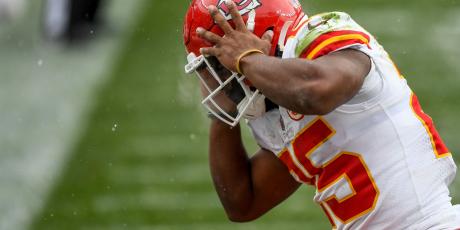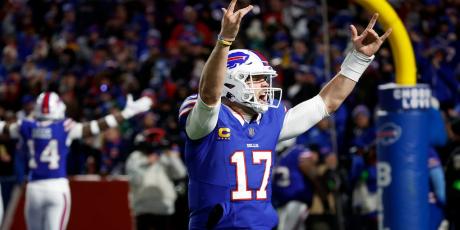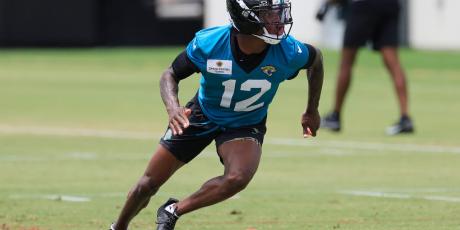Stop Taking Adrian Peterson Over Mark Ingram in Fantasy

In April the Saints added Adrian Peterson, the No. 2 fantasy running back two years ago, to their backfield alongside Mark Ingram, No. 8 last year, and top-15 in each of the past three years.
Is Ingram or Peterson the better fantasy pick in 2017?
Subscribe now to 4for4 Classic, Pro, or DFS for '17!
Is Mark Ingram Being Demoted?
While rumors of Ingram being a potential salary cap casualty can be easily rebuffed, it’s worth considering whether or not Ingram’s role will be scaled back in '17.
Ingram Has Hardly Been a Bell Cow (but Has Still Produced)
Aside from 2014, Ingram has never been a true featured runner, and his share of the Saints’ carries has been dwindling for the past two seasons now. Last season’s short-lived benching for fumbling aside, his shrinking workload is likely an attempt by the Saints' coaching staff at preserving his health, as he’s missed between 3-6 games in four of his six NFL seasons.
| Year | G | Rush Att | % of Tm | Target/G | % of Tm | Std RB Rk | PPR RB Rk |
|---|---|---|---|---|---|---|---|
| 2011 | 10 | 12.2 | 46.7% | 1.3 | 3.1% | 46 | 46 |
| 2012 | 16 | 9.8 | 42.4% | 0.6 | 1.5% | 35 | 42 |
| 2013 | 11 | 7.1 | 29.8% | 1.0 | 2.4% | 63 | 65 |
| 2014 | 13 | 17.4 | 68.2% | 2.8 | 6.9% | 15 | 14 |
| 2015 | 12 | 13.8 | 57.7% | 5.0 | 12.1% | 15 | 12 |
| 2016 | 16 | 12.8 | 50.7% | 3.6 | 8.6% | 10 | 8 |
In fantasy, Ingram has been able to offset his decreasing amount of rushes over the past two years with supreme efficiency, averaging 4.88 yards per carry over that span. Yards per carry tends to regress to the mean over time, but Ingram has averaged 4.68 over the last four seasons. (By comparison, Peterson has averaged 4.36 over that span.)
Ingram Can Still Be Active in the Passing Game
Ingram’s increased role in the passing game over the past three seasons has also been a boon to his fantasy numbers. Ingram shouldn't be expected to repeat 2015's 4.2 receptions per game, but somewhere between 2014's 2.2 and 2016's 2.9 is still realistic. Why?
While it's fair to consider rookie third-rounder Alvin Kamara a threat to Ingram’s passing-game work, Kamara is a less experienced pass protector who is more likely to cut into/replace altogether Travaris Cadet’s 54 targets from last season (Cadet is owed only $80,000 guaranteed), or make up some of the difference between Brandin Cooks’s 117 targets and however many newcomer Ted Ginn manages.
It seems like every year now that Peterson gets talked up in the passing game, but it's unlikely he'll truly be a threat to Ingram’s passing-down work, either. Peterson has averaged just 4.92 yards per target since 2013, compared to Ingram’s 5.67 on double the volume. Peterson has also been a less effective receiver (and runner) out of the shotgun, a formation which accounted for 73.6 percent of the Saints’ total pass attempts in '16.
Peterson Is Likely Slated for the Hightower Role
Given that Ingram has been highly effective of late when on the field, it’s unlikely that signing 32-year-old Peterson is signaling a demotion.
Instead, it’s likely the Saints indeed feel most comfortable giving Ingram around 50 percent of their rushing workload. With Drew Brees, fullbacks, and receivers having accounted for between 10-12 percent of the team’s rushing attempts per year of late, that still leaves roughly 40 percent of attempts unaccounted for.
Rather than demote Ingram, it’s a lot more conceivable that the Saints, knowing they have an effective, but injury-prone back and a sizeable chunk of carries unaccounted for, decided to take a low-risk gamble on a future Hall-of-Famer in Peterson, a back who could not only help preserve Ingram, but also play a featured role if necessary — especially after the team had success with another older back, Tim Hightower, in that same role. When Ingram has been active over the past two seasons, Hightower averaged just 9.8 touches per game, but when Ingram has been out, Hightower's usage ballooned to 24.0 touches per game.
The Saints have averaged 25.1 rushing attempts per game over the past three seasons. With the most likely outcome being Ingram handling about 50 percent of the rushing workload and Peterson handling up to 40 percent if no other backs are a factor, that would work out to 12.6 carries per game for Ingram and 10.0 for Peterson, while a (more unliklely) 50-50 split would net them 11.3 each.
Can Adrian Peterson Still Be Effective?
Being that the Saints have shown no issue with using a running back by committee to varying degrees, how much Peterson ultimately plays will come down to how effective he is. There's evidence to support both sides of the coin.
Potential reasons Peterson could be ineffective:
-
He looked like a shell of himself while averaging 1.9 yards per carry on 37 carries in '16.
-
He's 32 years old, an age where only nine running backs in the last 46 years have handled 160 carries and gained at least 4.0 yards per carry.
-
He had surgery to repair a torn meniscus last year.
Potential reasons Peterson could be effective:
-
He could improve on his poor '16 showing with better offensive line play, as the Vikings ranked 30th in adjusted line yards (3.37), while the Saints ranked first (4.59). (The Saints’ line does, however, take a hit with tackle Terron Armstead out until at least mid-season and center Max Unger potentially missing time.)
-
Like Ingram, Peterson could benefit from a reduced workload; he's handled 2,781 career touches in 10 regular seasons plus playoffs.
-
He could benefit from soft boxes, as except for Brett Favre’s 2009, the Vikings have never had a threatening passing game comparable to the Saints with Drew Brees.
-
He could end up being the goal-line back, as Ingram split carries inside the 10 50-50 with Hightower last year while both were active. Albeit slightly, Peterson (28.9%) has bested Ingram (27.1%) over the last four years at inside-the-10 TD conversion rate.
Ultimately, there’s no obvious answer to how effective Peterson will be -- it could go either way. Fantasy drafters will have to take Peterson’s wide range of outcomes into account.
The Bottom Line
Ingram has been a more effective runner and receiver than Peterson for a few years now, and he has more upside volume-wise in both areas as well. Peterson’s best path to matching Ingram’s fantasy production will be with TDs, which are the riskiest fantasy box score stat to depend on. Peterson would also benefit from an Ingram injury, but Peterson’s age and recent knee woes arguably make him a greater injury risk than Ingram at this point. What does this all mean for fantasy?
Mark Ingram has a higher floor and a higher ceiling than Adrian Peterson in 2017.
A case can be made for Peterson in standard leagues as lower-cost Ingram arbitrage...except that, as of June 26, Peterson is going as the RB19 in FF Calculator standard ADP — 11 spots ahead of Ingram. If that’s any indication as to how drafters will value Peterson come August, he would be ridiculously overvalued. 4for4 currently has Peterson ranked eight spots behind Ingram in standard scoring, a fairer assessment.
Sharper MFL10 ADP (PPR scoring) has Ingram as the RB24 and Peterson as the RB32 since June 15, but that may still not be accounting for Peterson’s risk in that format — 4for4’s PPR RB rankings have Peterson 18 spots behind Ingram.
Don’t let Peterson’s big name fool you — Ingram is the Saints running back shaping up as the sneaky '17 fantasy pick.
Subscribe now to 4for4 Classic, Pro, or DFS for '17!
- The Fantasy Value of Patriots Running Backs Mike Gillislee, James White, Dion Lewis & Rex Burkhead
- 6 Reasons Jordan Howard Will Not Be a Fantasy Football Bust
- Using Red Zone Expected Value to Find 5 Running Back Touchdown Regression Candidates
- What are the Most Predictable Year-to-Year Stats for Running Backs?
- The Underrated Fantasy Impact of Kenny Britt to the Browns
- Danny Woodhead Had RB1 Upside at This Time Last Year - Does He Still?
- Is Brandon Marshall Done?






















